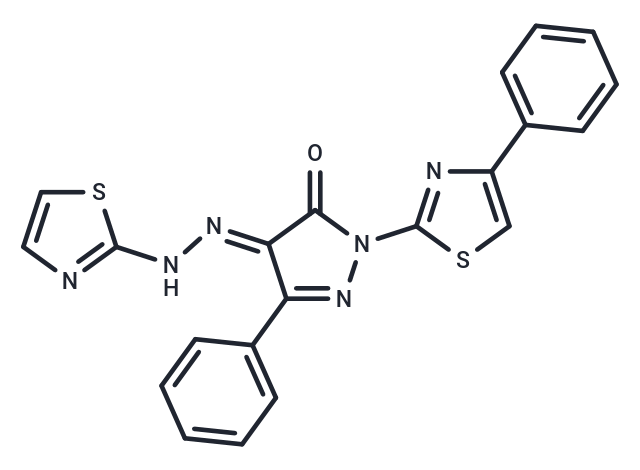Shopping Cart
- Remove All
 Your shopping cart is currently empty
Your shopping cart is currently empty

BTSA1 is a BAX activator that binds with high affinity and specificity to the N-terminal activation site and induces conformational changes to BAX leading to BAX-mediated apoptosis.

| Pack Size | Price | Availability | Quantity |
|---|---|---|---|
| 2 mg | $38 | In Stock | |
| 5 mg | $64 | In Stock | |
| 10 mg | $122 | In Stock | |
| 25 mg | $198 | In Stock | |
| 50 mg | $372 | In Stock | |
| 100 mg | $556 | In Stock | |
| 500 mg | $1,220 | In Stock | |
| 1 mL x 10 mM (in DMSO) | $70 | In Stock |
| Description | BTSA1 is a BAX activator that binds with high affinity and specificity to the N-terminal activation site and induces conformational changes to BAX leading to BAX-mediated apoptosis. |
| Targets&IC50 | Bax:144 nM (EC50), Bax:250 nM (IC50) |
| In vitro | BTSA1 has no capacity to directly activate the pro-apoptotic homolog BAK. BTSA1 treatment potently and dose-responsively induces membrane translocation of recombinant soluble BAX to the mitochondrial membrane, which is followed by induction of BAX oligomerization. BTSA1-induced BAX activation promotes apoptosis in cancer cells. BTSA1 reduces the viability of all AML cell lines in a dose-dependent manner with IC50 values ranged between 1 and 4 μM, which leads to complete effect within 24 hr treatment. It induces dose-dependent caspase-3/7 activation in all five AML cell lines[1]. |
| In vivo | BTSA1 potently suppresses human acute myeloid leukemia (AML) xenografts and increases host survival without toxicity. It is well-tolerated in mice with no toxic effects on healthy hematopoiesis, including healthy stem cell-enriched (LSK) cells, common myeloid progenitors, granulocyte-monocyte progenitors, and megakaryocyte-erythrocyte progenitors. BTSA1 has a substantial half-life in mouse plasma (T1/2 = 15 hr) and oral bioavailability (%F = 51), while a 10 mg/kg dose reaches sufficient levels (~15 μM) of BTSA1 to induce BAX activation and apoptosis in leukemia cells. Thus, BTSA1 is orally bioavailable with excellent pharmacokinetics, has significant anti-tumor activity in leukemia xenografts by promoting apoptosis, and at therapeutically effective doses it does not show any detectable toxicity in the hematopoietic system or other tissues[1]. |
| Molecular Weight | 430.51 |
| Formula | C21H14N6OS2 |
| Cas No. | 314761-14-3 |
| Smiles | O=C1N(N=C(\C1=N/Nc1nccs1)c1ccccc1)c1nc(cs1)-c1ccccc1 |
| Relative Density. | 1.49 g/cm3 (Predicted) |
| Storage | Powder: -20°C for 3 years | In solvent: -80°C for 1 year | Shipping with blue ice. | |||||||||||||||||||||||||||||||||||
| Solubility Information | DMSO: 60 mg/mL (139.37 mM), Sonication is recommended. | |||||||||||||||||||||||||||||||||||
Solution Preparation Table | ||||||||||||||||||||||||||||||||||||
DMSO
| ||||||||||||||||||||||||||||||||||||

Copyright © 2015-2025 TargetMol Chemicals Inc. All Rights Reserved.